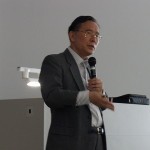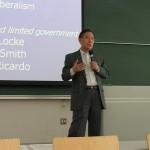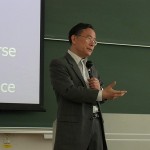2010年度法政大学法学部
Global Governance
■テーマ :「Global Governance of A Globalizing Economy」
■講 師 :長谷川 祐弘教授 法政大学法学部教授
■日 時 :2010年6月9日(水)13:30~15:00
■場 所 :法政大学市ヶ谷キャンパス 外濠校舎 307教室
■作成者 橋本佳奈 法政大学法学部国際政治学科2年
******************************
<講義概要>
International Regimes for Global Governance
(1) There are four kinds of the global governance. First one is international peace and security. The second regime is economic integration, market and structure. Thirdly, we will discuss the global environment. Lastly we discuss International norms, rules and laws.
(2)International Political Economy (IPE) means in the global economics that there is interdependence each influencing the other. Today we will discuss five components. First one is Classical Liberal Economics, which developed before the WW2. This economics developed the theory on how international actors and commons play. Second is about Neo-liberal economic theory. This has culminated in what we call Washington consensus by John Williamson. This was very powerful and influenced many strategies. Fourth, we will review the global financial crisis that took place in 1997-98, which is called Asia financial crisis that started in Thailand and spread to Indonesia, Korea and Russia. We will review briefly the crisis which we are facing now in 2010. It’s manifested in what we call euro crisis.
(3)Classical Liberalism is called Laissez-fair liberalism, traditional liberalism and market liberalism. These are developed by three people, John Lock, Adam Smith and David Ricardo. John Lock said we have to have government, but government cannot be dictator. We have social contract between the government and people. Second one is Adam Smith. Adam Smith wrote the book “An Inquiry into the Nature and Causes of The Wealth of Nations.” In this book, he wrote how the nation can inquire the wealth. Lastly, David Ricardo was the specialist on international trade. He showed in his book, “Principles of Political Economy”, the theory of comparative advantage and mutual benefit from free trade and specialization.
2.Washington Consensus
(1) In 1989, John Williamson published the paper which is known as Washington consensus. Basically, it was effective development strategies associated with the Washington-based institutions, for examples, IMF, World Bank and US Department of Treasury. It was also a promotion of the Structural Adjustment in times of financial crisis. He had 10 points; first, he said about reduction of public spending from subsidies to key pro-growth, pro-poor like primary education, health and infrastructure. Second, we need Tax reform. We have to have moderate marginal tax rates, and improve incentives for more profit and earning. Let people work more. Thirdly, liberalize interest rates to be determined by market. Fourthly, we have to promote competitive exchange rate, avoid currency controls that was aimed at expanding export. Sixthly, we need trade liberalization, so we need to reduce or eliminate tariffs. Seventh, we need liberalization of foreign direct investment, privatization of state enterprises to increase efficiency, and we have to reduce government regulations against entry and exit of foreign firms. Lastly, we secure property rights in the private sector.
(2) The first global financial Crisis was Asia Crisis. World realized that we are linked together. Developing countries criticized Indonesia on privatization, liberalization and market liberalization. IMF director general and Suharto signed the letter of agreement for structural adjustment. Structural Adjustment Program was done by World Bank and IMF. They called for opening the economy for free trade, adjusting prices and promoting market competition.


